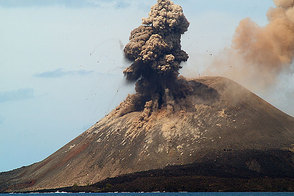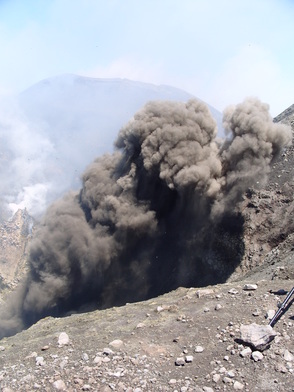 Click for link to original site. Photo is Anak Krakatau Vulcanian eruptions, generally considered as the next step up in explosiveness from Hawaiian eruptions, are very distinct from other forms of activity such as Strombolian as they are related to the emission of mostly ashy pyroclasts and blocks in more voluminous amounts. This is in direct contrast to the incandescent material ejected during Hawaiian and Strombolian events. These events can occur on time-scales of minutes to hours or more. They are generally thought to be caused by the build-up of gas below a cooler plug of material which builds up sufficient amounts of pressure to explosively force the plug of material from the conduit. This then creates a column between hundreds of metres and kilometres high filled with ash and can also lead to the ejection of large metre size blocks. Typically this type of eruption occurs with higher viscosity magmas which don't allow the rapid rise and expansion of bubbles (and hence allow large amounts of passive degassing). This then allows the upper conduit to cool. Of course there are always exceptions and different situations when considering volcanic eruptions! Where do Vulcanian eruptions they get their name from? No surprises here when I tell you it is from the Volcano Vulcano, one of the Aeolian Island volcanoes which has most commonly exhibits this kind of activity. There are several great textbooks with more information on this type of activity - Volcanoes by Lockwood and Hazlett and of course Volcanoes by Francis and Oppenheimer. I am sure there are more! Comments are closed.
|
Archives
July 2023
|


 RSS Feed
RSS Feed